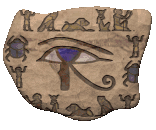Egyptian Religion and Beliefs


What part might religion and beliefs have in your life?
beliefs
Gods and Goddesses
The Ancient Egyptians practiced polytheism. They believed in as many as 2,000 gods and goddesses. So many deities were worshipped in different cities and often different times. They were both male and female. As is often true of early cultures, they frequently represented the powerful forces of nature, such as the sun, moon, wind, and rain. They also, however, represented human events and activities. Taweret, part hippopotamus, was goddess of maternity and childbirth. She protected mothers and newborns. Anubis, the jackal-headed god of death, guarded over the spirit at death and into the afterlife.These ancient deities took the forms of both humans and of half-human/half-animal beings. Ra (ray), the Sun god, is depicted with the body of a human and the head of a falcon. The importance of their physical form is that they walked the earth. They ate, drank, gave birth, went into battle, laughed and cried. They were beings with whom people could identify. They faced great challenges and overcame them using god-like powers, but still drawing on their own strengths. One's own inner resources, then, could be used to overcome obstacles in life. With deities such as these, religion could be part of all Egyptian's lives even when hidden magic, high ritual, and sacred texts were saved for the priests and other temple dwellers.
The Egyptian gods and goddesses each have their own story and are best understood through the telling of it. Two of the most important figures are the god Thoth, and the goddess Basta.

Thoth was god of knowledge, writing, secrets, and scribes.
Read about him by clicking on his image.

One of the most powerful Goddesses was Bast, patron of cats,
secrets, and women. Read about her by clicking on her image.
To see a complete list of gods and goddesses look here.
http://egyptianmyths.net/section-deities.htm
The Creation Story
The Egyptians had many tales about how the earth began. One is that it began as an ocean in darkness. Then a piece of dry land rose up and the sun god, Ra, appeared. He created light and all things.Here, the eye of Hurus is shown is Egyptian hieroglyphs.

The Eye of Hurus
daily practice
The Soul and Afterlife
The Egyptians believed death was a transitional stage – a journey to a better life in the next world. It was only here they reached their true potential. They practiced many rituals. Elaborate embalming procedures took place. The chief embalmer wore the mask of a jackal (the god Anubi), and performed "the opening of the mouth" to give the soul the ability to speak, eat and move. Each soul, upon burial, would begin its journey in the Underworld. It was a dark, terrifying place of great danger which must be passed through. If the soul of the dead succeeded in the passage, the next stage was to meet the deities who would measure each heart. If the heart was pure, that soul would be allowed entrance to the Next World. This was all part of a "rebirth" process. Life in the next world included union with the physical body and the ability to eat, drink, and partake of life's physicality.




